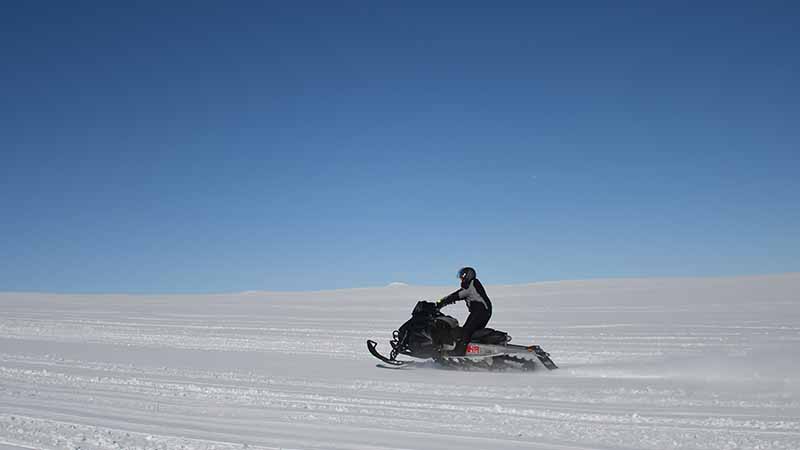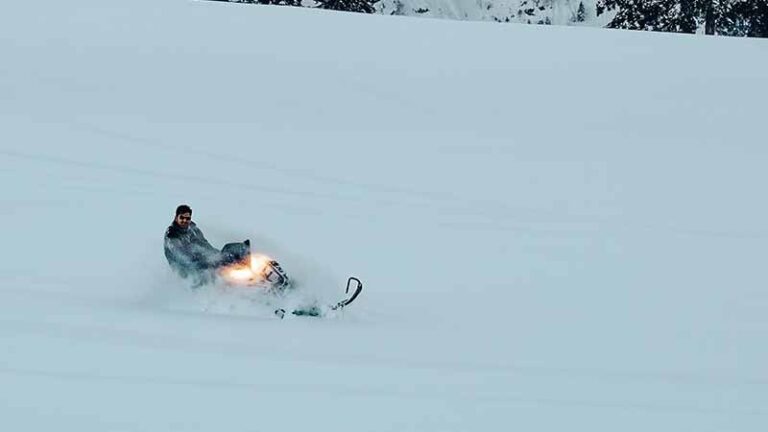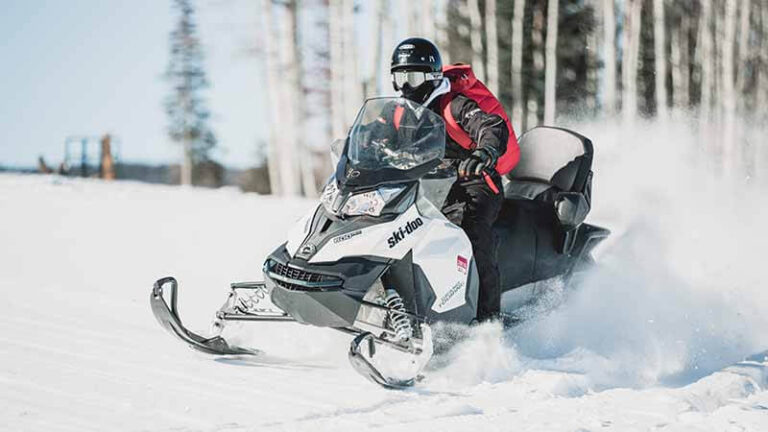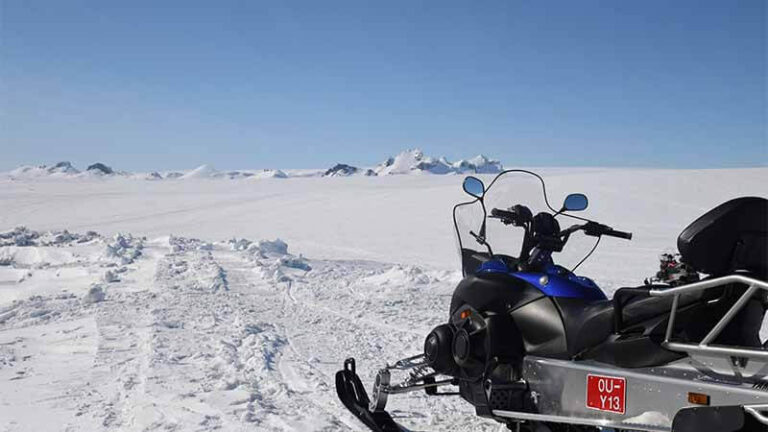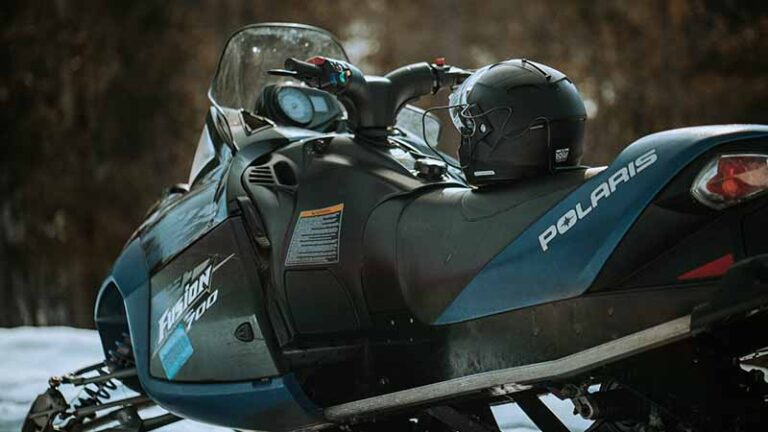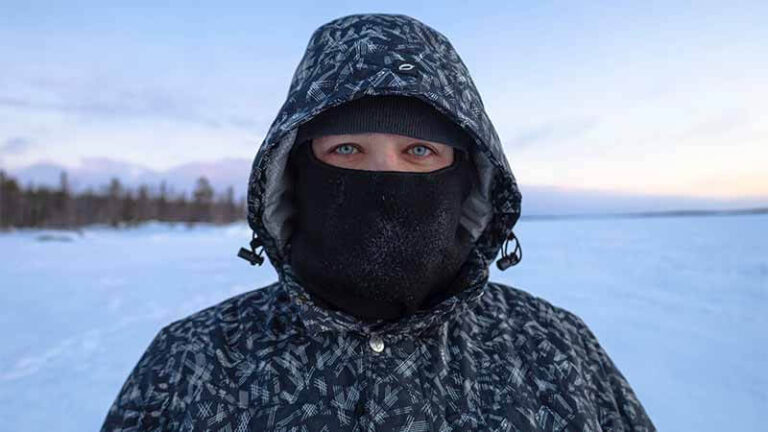How Fast Can a Snowmobile Go?
A snowmobile is a motorized vehicle developed specifically for winter travel on snow and ice. It usually has a broad track or skis to provide traction and agility on icy terrain. Snowmobiles are popular leisure vehicles, allowing riders to explore vast snowy landscapes and visit remote regions that would otherwise be difficult to reach during the winter.
The thrill of snowmobiling and its popularity
Snowmobiling provides riders with a thrilling and exhilarating experience. Gliding around snowy landscapes at various speeds creates a sense of adventure and thrill. Winter Wonderlands’ adrenaline rush and freedom of movement attract various enthusiasts, from adrenaline junkies to families looking for winter pleasure. Snowmobiling is extremely popular in areas with a lot of snow, where it becomes a major winter recreational activity.
The importance of understanding snowmobile speed limits
Understanding snowmobile speed limitations is critical for riding safely and responsibly. Snowmobiles may achieve high speeds, and breaking speed limits can result in accidents and collisions with other riders, obstructions, or wildlife. Different places and snowmobile routes may have different speed limits to guarantee rider safety and environmental protection.
Following these speed limitations helps to avoid accidents, reduce trail damage, and preserve the natural beauty of winter landscapes. Snowmobiling responsibly, which includes obeying speed limits, promotes a fun and safe experience for all riders, and contributes to the appeal and sustainability of snowmobiling as a winter activity.
The Mechanics of Snowmobile Speed
The basic components of a snowmobile
Snowmobiles are made up of various parts that work together to propel the vehicle and manage its movement on icy terrain. These elements are as follows:
- Chassis: The snowmobile’s frame that supports all other components.
- Engine: The source of power that propels the snowmobile’s track or skis.
- Tracks or skis: These provide traction and allow the snowmobile to move on snow and ice.
- Suspension System: Assists in the absorption of shocks and the maintenance of stability, resulting in a smoother ride.
- Steering System: Allows the rider to control the snowmobile’s direction.
- Drive System: Allows mobility by transferring power from the engine to the track or skis.
- Fuel Tank: Holds the fuel required to run the engine.
- Exhaust System: Discharges engine exhaust fumes away from the rider.
How snowmobile engines work
Snowmobile engines are primarily internal combustion engines with two or four-stroke cycles. The following are the main steps in their operation:
- Intake: The engine draws air and fuel into the combustion chamber via the intake valve (four-stroke) or the compression stroke (two-stroke).
- Compression: In the combustion chamber, the piston compresses the air-fuel mixture, raising its pressure and temperature.
- Ignition: The compressed air-fuel mixture is ignited by a spark plug, resulting in a controlled explosion.
- Power: As a result of the explosion, the piston is pushed downward, transforming the pressure into mechanical energy that turns the crankshaft.
- Exhaust: The exhaust valve (four-stroke) opens to let the burnt gases from the combustion chamber escape, or the piston (two-stroke) uncovers the exhaust port, allowing the exhaust gases to leave.
Factors influencing a snowmobile’s top speed
The maximum speed of a snowmobile is affected by a number of factors, including:
- Engine Power: The higher the potential speed, the more powerful the engine.
- Track or Ski Design: The design of the track or skis affects traction and stability, as well as the capacity of the snowmobile to maintain speed.
- Track Length: Longer tracks provide higher traction, which aids acceleration and top speed.
- Weight: The weight of the snowmobile, including the rider and any load, influences its ability to travel and accelerate efficiently.
- Terrain and Snow Conditions: Due to more excellent resistance, deep snow or uneven terrain can limit a snowmobile’s speed.
- Altitude: Higher altitudes can have an effect on engine performance, resulting in slower top speeds.
- Maintenance: Proper engine and component maintenance promotes optimal engine and component performance, which can affect total speed.
Riders may maximize performance and have safer and more exhilarating snowmobiling adventures by recognizing these aspects and properly maintaining their snowmobiles.
Types of Snowmobiles and Their Speed Capabilities
Trail or recreational snowmobiles and their speed range
The most prevalent form of snowmobile utilized for ordinary snowmobiling activities is the trail or recreational snowmobile. They are intended for riders looking for a good mix of comfort, performance, and versatility on well-groomed trails and varied terrain. Trail snowmobile speeds vary depending on model, engine size, and other considerations, but they can achieve speeds of:
- Low to mid-range models: 60 to 70 mph (96 to 113 km/h)
- Mid-range to high-end models: 80 to 100 miles per hour (129 to 161 kilometers per hour).
The performance or high-performance snowmobiles and their top speeds
Performance or high-performance snowmobiles are designed for speed, power, and agility, and are aimed at riders who seek high-speed thrills and adrenaline rushes. These specialist machines exceed trail snowmobiles in terms of acceleration and top speed. Performance snowmobile top speeds can range from:
- 90 to 110 mph (145 to 177 km/h) for regular high-performance models
- Speeds of 120 mph (193 km/h) or higher for specialist, customized, or race-ready versions
Utility snowmobiles and their speed limitations
Utility snowmobiles, sometimes known as work snowmobiles, are built to carry big loads and complete utilitarian jobs in isolated and cold locations. While these snowmobiles are excellent for pulling, hauling, and transporting items, they are not designed for speed and have limited top speeds that typically range from:
- 30 to 50 mph (48 to 80 km/h)
Utility snowmobiles prioritize reliability, torque, and durability over high-speed performance, making them more suited to certain duties and work objectives than leisure riding.
Understanding the various types of snowmobiles and their speed capabilities enables users to select the model that best fits their intended use and desired speed experiences. Furthermore, while enjoying the thrill of snowmobiling, it is critical to operate all snowmobiles safely, respecting speed limits and the safety of oneself and others.
Speed Records and Achievements
Notable snowmobile speed records in history
Snowmobile fans and professional riders have pushed the speed limits of these winter machines throughout history. Several noteworthy speed records and accomplishments stand out:
- Global Snowmobile Speed Record: The official global snowmobile speed record is above 200 miles per hour (322 kilometers per hour). This record was set in controlled settings on a specially modified snowmobile.
- ISOC Snocross Records: During professional snowmobile racing, riders achieve incredible speeds on snocross tracks, reaching speeds of up to 80 mph (129 km/h).
- Grass Drags Records: Speeds for modified and racing-specific snowmobiles have exceeded 150 mph (241 km/h) in grass drag competitions, where snowmobiles compete on grassy surfaces.
Technological advancements and their impact on speed achievements
Technological developments in snowmobile design and engineering have played an important part in breaking speed records. Among the key innovations are:
- Lightweight Materials: The adoption of lightweight materials such as carbon fiber and aluminum has lowered overall snowmobile weight while increasing acceleration and speed.
- High-Performance Engines: Today’s snowmobile engines are more powerful and efficient, with greater horsepower and torque for faster acceleration.
- Advanced Suspension Systems: Suspension technology advancements have improved stability and handling, enabling higher speeds without sacrificing control.
- Aerodynamics: Design enhancements such as windshields and aerodynamic elements minimize drag while increasing peak speed capability.
- Advanced Track and Ski Designs: Advanced track and ski designs provide higher traction and less friction, which contributes to faster performance.
Safety precautions during speed record attempts
Attempting high-speed records on snowmobiles entails major risks, and safety steps are required to minimize potential hazards. Some common safety precautions used during speed record attempts are as follows:
- Professional Training: Riders attempting speed records should have specialist training in order to deal with high speeds and difficult conditions.
- Appropriate Safety Gear: Riders use specialized safety gear, such as helmets, body armor, and protective clothes, to reduce injuries in the event of an accident.
- Closed and regulated conditions: Speed record attempts are undertaken in closed and regulated conditions, limiting the possibility of collisions with other riders or obstructions.
- Emergency Response: During record attempts, medical staff and emergency response teams are present to provide rapid aid if necessary.
- Inspection and Maintenance: Thorough snowmobile inspection and maintenance assure peak performance and limit the danger of mechanical failure during high-speed runs.
The snowmobile community continues to set and break speed records by combining technological improvements, competent riders, and stringent safety standards, always pushing the boundaries of what these machines can achieve. However, it is critical to realize that such high-speed pursuits necessitate constant attention to safety.
Factors Affecting Snowmobile Speed
Environmental conditions and their impact on performance
The environment has a significant impact on the performance and speed of a snowmobile. Among the most important factors are:
- Air Density: Because cold air is denser, it provides more oxygen to the engine, resulting in improved combustion and increased power production.
- Humidity: Excessive humidity can impair engine performance by reducing air intake and combustion efficiency.
- Barometric Pressure: Variations in barometric pressure can have an impact on engine power and performance at various altitudes.
- Wind: Strong headwinds can cause resistance, reducing top speed and fuel economy.
Snow conditions and their effect on speed
The type and condition of the snow have a considerable impact on the speed and handling of a snowmobile:
- New Powder: Riding in new, deep powder snow demands more power and may lower the speed of the snowmobile due to resistance.
- Packed Snow: Packed or groomed snow improves traction and enables faster speeds with less effort.
- Icy Surfaces: Icy conditions diminish traction, decreasing acceleration, and cornering ability, as well as potentially limiting top speed.
- Wet Snow: Wet and mushy snow can clog the track of a snowmobile, resulting in slower speeds and lower performance.
Altitude and temperature considerations
Changes in air density and pressure, altitude, and temperature can have an impact on snowmobile engine performance:
- Altitude: As altitude increases, air density falls, resulting in decreased engine power and top speed unless the snowmobile’s engine is altitude-adjusted.
- Temperature: Extremely cold temperatures might interfere with gasoline combustion, making it difficult to start the snowmobile and reducing overall engine performance.
- Carburetor Tuning: To improve engine efficiency and maintain speed at varying altitudes and temperatures, proper carburetor modifications may be required.
Snowmobilers must understand and adjust to various environmental, snow, altitude, and temperature considerations. To ensure a safe and fun snowmobiling experience, riders must alter their riding style and expectations dependent on the weather.
Furthermore, regular snowmobile maintenance and tuning can help maximize performance and overcome the hurdles provided by many elements impacting speed.
Safety Considerations
Snowmobile speed limits and regulations
Understanding and following snowmobile speed restrictions and rules is critical for the safety of both riders and other route users. Speed limits vary by location and snowmobile area, and are normally imposed to preserve safe riding conditions and prevent accidents.
Snowmobile speed limits may vary depending on terrain, visibility, and proximity to inhabited areas. Riders must be conversant with local legislation and respect speed limits in order to avoid collisions, maintain control, and protect the environment and routes.
The importance of understanding your snowmobile’s capabilities
Each snowmobile type has its own distinct set of performance qualities, such as acceleration, top speed, and maneuverability. It is critical for riders to understand their snowmobile’s capabilities in order to avoid pushing the vehicle beyond its capabilities.
Riding a snowmobile at a too-fast speed for its design or terrain can result in loss of control, accidents, and injuries. Knowing the weight, engine power, and track or ski design of the snowmobile can assist riders make informed speed selections and choose appropriate routes that meet the snowmobile’s capabilities.
Protective gear and safety measures for high-speed riding
Wearing the proper protective gear when riding at high speeds is critical to minimizing the risk of injury in the case of an accident. Among the most important safety precautions are:
- Helmet: A correctly fitting helmet is vital for preventing head injuries and protecting the head from impacts.
- Eye Protection: Goggles or a full-face shield keep snow, debris, and wind out of your eyes, maintaining good vision.
- Body Armor: Protective apparel, such as body armor and padded suits, protects the chest, back, and limbs.
- Gloves: Insulated gloves protect the hands from the elements such as cold, wind, and potential damage.
- Boots: Sturdy, insulated boots with adequate traction aid in maintaining control and protecting the feet and ankles.
- Reflective Equipment: Visibility is essential for snowmobilers. Wearing reflective clothing or adding reflective elements to your snowmobile improves visibility to other riders and vehicles.
- Ride within Your Skill Level: Riding at high speeds necessitates sophisticated expertise. Riders should progressively increase their speed as they develop confidence and experience.
- Avoid Riding Alone: Ride with a group or a companion whenever feasible to provide assistance in the event of an emergency.
Snowmobile fans can enjoy the excitement of high-speed riding while limiting the hazards connected with this fun winter pastime by prioritizing safety and following these recommendations. Snowmobiling responsibly makes the trails safer and more pleasant for everyone.
Tips for Maximizing Snowmobile Speed
Proper maintenance and tuning for optimal performance
- Regular maintenance and tuning are required to maximize the performance and speed of a snowmobile.
- Check and change the engine oil, spark plugs, and air filter on a regular basis to guarantee optimal combustion and engine performance.
- Inspect and adjust the drive belt for proper tension and wear to transfer power to the track or skis efficiently.
- Maintain appropriate track or ski conditions by inspecting for damage or wear and maintaining correct tension.
- Check that the suspension is appropriately adjusted to provide the best stability and control possible.
- Check that the snowmobile’s cooling system works correctly to avoid overheating and performance difficulties.
Choosing the right snowmobile for your speed preferences
It is critical to choose a snowmobile that matches your riding style and speed preferences. When selecting a snowmobile for maximum speed, consider the following factors:
- Engine Size and Type: Higher displacement engines have the potential for higher power and speed.
- Performance Features: Look for high-performance versions with features that improve acceleration and speed.
- Track Length: Longer tracks provide more traction and stability, allowing for faster speeds.
- Suspension: At greater speeds, high-performance suspension systems improve handling and stability.
Improving riding techniques to increase speed safely
Riders can improve their speed and safety by practicing the following riding techniques:
- Positioning: Ride in a balanced, forward-leaning position to optimize weight distribution and traction.
- Throttle Control: Apply throttle gradually and avoid abrupt movements to retain control and avoid skidding or fishtailing.
- Cornering: To maintain speed while safely navigating turns, practice smooth and controlled cornering methods.
- Braking: To avoid skidding and maintain stability, use the brakes sparingly and avoid rapid braking.
- Stay Alert: To make informed decisions at high speeds, be aware of the terrain, hazards, and other riders.
Remember that maximizing speed should be done properly and within the boundaries of your skill level and the capabilities of the snowmobile. While experiencing the thrill of high-speed snowmobiling, safety should always come first.
Speed vs. Safety: Finding the Right Balance
The thrill of speed vs. responsible snowmobiling
The thrill of speed is an intrinsic feature of snowmobiling that draws many fans to the sport. The adrenaline of gliding across snowy landscapes at high speeds creates a sense of adventure and exhilaration. However, it is critical to balance the exhilaration of snowmobiling with safe measures.
Speeding without regard for safety precautions and trail laws can result in accidents, injuries, and bad environmental consequences. Snowmobiling responsibly entails enjoying the thrill of speed while respecting the safety of oneself, other riders, and the surrounding environment.
Understanding the risks of high-speed riding
Riding at high speeds entails inherent risks and challenges. Riding at fast speeds necessitates sophisticated riding abilities as well as enhanced awareness of the terrain and surroundings. Extending the capabilities of a snowmobile or pushing the limits on unfamiliar or difficult terrain can result in loss of control, crashes, and accidents.
Furthermore, in the winter, weather conditions and visibility can change quickly, increasing the risks of high-speed cycling. Understanding these dangers is critical for making sound judgments about when and where to accelerate and when to prioritize safety.
Emphasizing safety and respect for other riders and the environment
Snowmobile riders should always prioritize safety. This includes following speed restrictions, wearing proper safety equipment, and exercising responsible riding skills. Respecting the space of other riders on the trails ensures a safe and fun experience for everyone.
Additionally, snowmobilers should be environmentally responsible and adhere to trail restrictions in order to limit trail damage and preserve the natural beauty of winter landscapes. Emphasizing safety and respect for others and the environment helps to foster a positive snowmobile community and supports the sport’s long-term viability.
A productive and fun snowmobiling experience requires striking the correct balance between speed and safety. Riders may continue to enjoy the thrill of speed while protecting themselves, others, and the natural winter environment by adopting ethical snowmobiling habits.
Conclusion
To summarize, prudent snowmobiling and adhering to speed limitations are critical in guaranteeing the safety and long-term viability of this thrilling winter pastime. While the thrill of gliding across snowy landscapes and experiencing the rush of speed is appealing, it is critical to establish a balance between exhilaration and responsible behavior.
Snowmobilers can enjoy the thrill of snowmobiling while keeping themselves and others safe by following safety standards, observing speed limits, and knowing the risks involved with high-speed riding.
Within the snowmobiling community, encouraging ethical snowmobiling habits develops a culture of safety and respect for others and the environment. Riders must prioritize their own safety as well as the safety of other snowmobilers, wildlife, and the natural winter scenery.
Snowmobilers help to preserve the beauty and integrity of snowmobiling destinations for future generations by following trail laws, keeping correct equipment, and making responsible decisions.
Enjoying the thrill of snowmobiling while preserving everyone’s safety benefits not just the individual’s experience but also the snowmobile community as a whole. Riders can reduce accidents and injuries by using safe riding tactics, wearing the correct safety equipment, and recognizing their snowmobile’s capabilities. This responsible attitude promotes friendship and respect among snowmobilers, resulting in a friendly environment for enthusiasts of all ages and skill levels.
Snowmobiling, in the end, is a thrilling winter hobby that combines excitement with the peacefulness of snowy surroundings. Snowmobilers may continue to enjoy this beloved sport while guaranteeing its preservation for years to come by accepting safety precautions, sticking to speed limits, and cherishing the environment.
Whether riding groomed trails, exploring backcountry routes, or setting speed records, responsible snowmobiling ensures that the thrill of snowmobiling remains a safe and fun experience for all involved.

